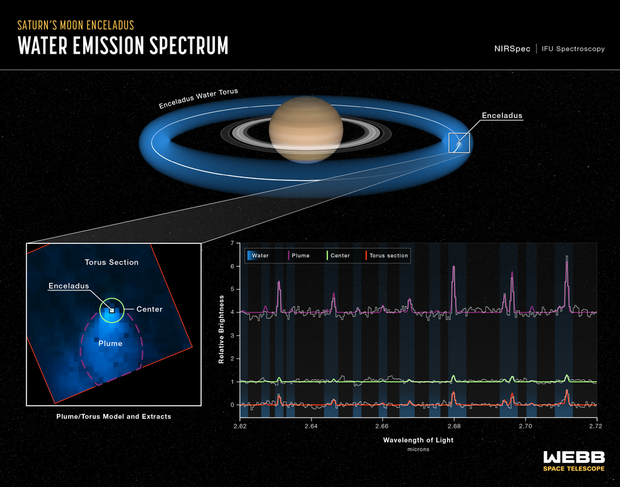The James Webb Space Telescope has identified an enormous stream of water vapor erupting from the surface of one of Saturn's moons, NASA announced this week. The plume measures at least 6,000 miles long — which is already more than twice the width of the United States — making it the largest of its kind detected on the distant moon Enceladus.
Described by scientists as an "ocean world" and characterized by NASA as one of the most compelling places to probe for extraterrestrial life, Enceladus is coated in a distinctive, icy outer shell. Beneath it, the moon is essentially a salt water reservoir wrapped around a rocky core. Cracks in the surface of Enceladus, sometimes called "tiger stripes," allow geyser-like jet streams to spew out from under the ice and into space, potentially acting as an important water source for the whole of the Saturnian system.
The massive plume detected most recently by the Webb Telescope is of particular interest to researchers because of both its size and strength. Although Enceladus is among Saturn's largest moons, of which there are at least 124, according to NASA, its 313-mile diameter makes it just about 4% of the Earth's size. The 6,000-mile plume, detected by the telescope as it blasted from the moon's south pole toward Saturn's trademark rings, is roughly 20 times the length of Enceladus itself.

"When I was looking at the data, at first, I was thinking I had to be wrong. It was just so shocking to detect a water plume more than 20 times the size of the moon," said Geronimo Villanueva, a planetary scientist at NASA and a lead author of the Enceladus study, in a statement. "The water plume extends far beyond its release region at the southern pole."
Scientists also determined that water vapor gushes out through the stream at a rate of about 79 gallons per second — fast enough to fill an Olympic-sized swimming pool in a couple of hours, NASA said. It may even be powerful enough to feed the rest of the Saturnian water system.
While evaluating the Webb data, scientists noticed that the plume extending from the south pole of Enceladus directly supplies a ring of water that forms a circle around the outer rings of Saturn, along the path of the moon's rapid, 33-hour orbit.
Villanueva said the moon creates a trail of water like a "halo," according to NASA, and noted that about 70% of the water emitted through the plume ultimately escapes the ring to supply Saturn's water system at large. Astronomers determined that the other 30% stays within the halo.
"As it whips around Saturn, the moon and its jets are basically spitting off water, leaving a halo, almost like a donut, in its wake," said Villanueva. "In the Webb observations, not only was the plume huge, but there was just water absolutely everywhere."
Scientists will continue to use the Webb telescope to study Enceladus, with the hope that learning more about the moon, and how volcanic plumes like this one may support its surrounding environment, provides greater insight into the salty ocean beneath its surface and whether that setting could support some form of life beyond Earth.
Thanks for reading CBS NEWS.
Create your free account or log in
for more features.


